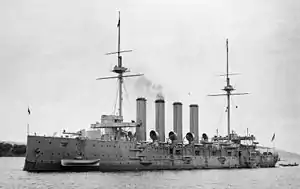Cressy-class cruiser
The Cressy-class cruiser was a class of six armoured cruisers built for the Royal Navy around 1900. Their design's incorporation of a pair of 9.2-inch guns and armoured sides served to address criticism directed against the previous Diadem class — advances made possible by their 1,000 ton increase in displacement over their predecessors. The ships were notably stable, except for a susceptibility to pitching.[1]
 HMS Euryalus at anchor in Australia | |
| Class overview | |
|---|---|
| Name | Cressy class |
| Operators | |
| Preceded by | Diadem class |
| Succeeded by | Drake class |
| Built | 1898–1902 |
| In service | 1901–1920 |
| Completed | 6 |
| Lost | 3 |
| Scrapped | 3 |
| General characteristics | |
| Type | Armoured cruiser |
| Displacement | 12,000 long tons (12,000 t) (normal) |
| Length | 472 ft (143.9 m) (o/a) |
| Beam | 69 ft 6 in (21.2 m) |
| Draught | 26 ft 9 in (8.2 m) (maximum) |
| Installed power |
|
| Propulsion | 2 × shafts; 2 × triple-expansion steam engines |
| Speed | 21 knots (39 km/h; 24 mph) |
| Complement | 725–760 |
| Armament |
|
| Armour | |
Service
Until 1908, the ships served in Home waters, the Mediterranean and the Far East. On the outbreak of the First World War Cressy, Aboukir, Hogue, Bacchante and Euryalus formed the Seventh Cruiser Squadron. Due to the obsolescence of the ships and because they were crewed by inexperienced reservists the squadron was known as the "Live Bait Squadron". This epithet proved prophetic when Cressy, Hogue and Aboukir were sunk in a single action on 22 September 1914 by the German submarine U-9 near the Dutch coast. After the first cruiser had been hit, the following cruisers both came to a dead halt to pick up survivors, making themselves easy targets for torpedoes.[2]
Ships
- HMS Cressy: launched 4 December 1899, torpedoed and sunk 22 September 1914
- HMS Sutlej: launched 18 November 1899, scrapped 9 May 1921
- HMS Aboukir: launched 16 May 1900, torpedoed and sunk 22 September 1914
- HMS Hogue: launched 13 August 1900, torpedoed and sunk 22 September 1914
- HMS Bacchante: launched 21 February 1901, scrapped 1 July 1920
- HMS Euryalus: launched 20 May 1901, scrapped 1 July 1920
Building Programme
The following table gives the build details and purchase cost of the members of the Cressy class. Standard British practice at that time was for these costs to exclude armament and stores. The compilers of The Naval Annual revised costs quoted for British ships between the 1905 and 1906 editions.
| Ship | Builder | Engine Maker |
Date of | Cost according to | Fate | ||||
|---|---|---|---|---|---|---|---|---|---|
| Laid Down | Launch | Completion | (BNA 1904)[3] | (BNA 1906)[4] | |||||
| Cressy | Fairfield, Govan | Fairfield | 12 October 1898 | 14 December 1899 | 28 May 1901 | £780,110 | £749,324 | torpedoed 22 Sept 1914 | |
| Sutlej | J Brown Clydebank | Clydebank Company |
15 August 1898 | 18 November 1899 | 6 May 1902 | £790,706 | £755,690 | scrapped 9 May 1921 | |
| Aboukir | Fairfield, Govan | Fairfield | 9 November 1898 | 16 May 1900 | 3 April 1902 | £783,883 | £751,118 | torpedoed 22 Sept 1914 | |
| Hogue | Vickers, Barrow | Vickers | 14 July 1898 | 13 August 1900 | 19 November 1902 | £787,507 | £749,809 | torpedoed 22 Sept 1914 | |
| Bacchante | John Brown Clydebank | John Brown | 15 February 1899 | 21 February 1901 | 25 November 1902 | £787,230 | £787,230 | scrapped 1 July 1920 | |
| Euryalus | Vickers, Barrow | Vickers | 18 July 1899 | 20 May 1901 | 5 January 1904 | £817,880 | £782,901 | scrapped 1 July 1920 | |
Image gallery
 Right elevation and deck plan, from Brassey's Naval Annual 1906
Right elevation and deck plan, from Brassey's Naval Annual 1906 Right elevation of 9.2 inch gun turret
Right elevation of 9.2 inch gun turret Rear elevation of 9.2 inch gun turret
Rear elevation of 9.2 inch gun turret
Notes
1. All three ships Cressy, Hogue and Aboukir were sunk under an hour by the German submarine SM U-9.
Footnotes
- Conway's All the World's Fighting Ships 1860–1905, pp. 68–69
- "Time Team s20". Channel 4. Channel 4. Retrieved 18 May 2015.
- Brassey's Naval Annual 1904, p212-219
- Brassey's Naval Annual 1906, p208-215
Bibliography
- Brassey, T.A. (ed) The Naval Annual 1904
- Chesneau, Roger & Kolesnik, Eugene M., eds. (1979). Conway's All the World's Fighting Ships 1860–1905. Greenwich: Conway Maritime Press. ISBN 0-8317-0302-4.
- Corbett, Julian. Naval Operations to the Battle of the Falklands. History of the Great War: Based on Official Documents. Vol. I (2nd, reprint of the 1938 ed.). London and Nashville, Tennessee: Imperial War Museum and Battery Press. ISBN 0-89839-256-X.
- Friedman, Norman (2012). British Cruisers of the Victorian Era. Barnsley, South Yorkshire, UK: Seaforth. ISBN 978-1-59114-068-9.
- Friedman, Norman (2011). Naval Weapons of World War One. Barnsley, South Yorkshire, UK: Seaforth. ISBN 978-1-84832-100-7.
- Leyland, J. and Brassey, T.A. (ed)The Naval Annual 1906
- Massie, Robert K. (2004). Castles of Steel: Britain, Germany, and the Winning of the Great War at Sea. London: Jonathan Cape. ISBN 0-224-04092-8.
- Silverstone, Paul H. (1984). Directory of the World's Capital Ships. New York: Hippocrene Books. ISBN 0-88254-979-0.